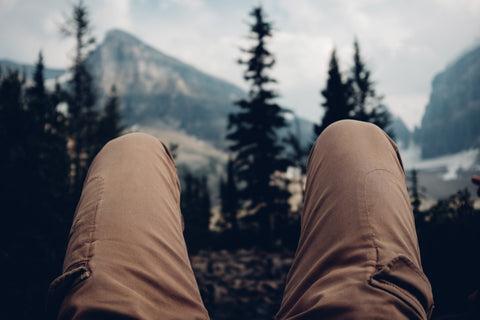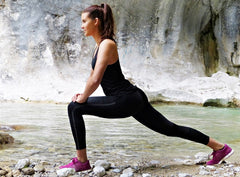Protecting your Knees While Hiking

Protecting your Knees While Hiking
Hiking offers so many health benefits. Cardio. Strength training. Blood pressure improvements. Heart health. Plus the fun of getting outdoors. Besides . . . who wants to be stuck on a treadmill?
But how do you protect your knees on long hikes? How do you deal with with steep terrain, rocks and uneven surfaces? How do you avoid “hiker’s knee”? This is not just an issue for elderly or obese people.
Research has found that forces on the knee joint go up exponentially with added weight from backpacks, and steep grades. Also, longer strides, which happen during hikes, place higher weight on the knees. Even children and teenagers have suffered from knee injuries from improper hiking.
A survey of tactics that protect and improve knees include:
Tools and Equipment
- Consider wearing a knee brace with open knee cap
- Gel inserts
- Firm fitted hiking boots (avoid boots that are too large)
- Trekking poles - According to the results of some previous studies, the use of a trekking pole could reduce lower limb joint forces by as much as 25%. This is especially true for obese hikers. Muscle soreness was significantly lower at 24 and 48 h after the trek
- Compression socks – these allow improved blood flow in the legs

- Reduce pack weight - Keep your backpack weight low. Avoid unnecessary items like ipads, chargers, heavy camera equipment. Consider a “photo-free” hike.
Trekking Pole Essentials

- Two is better than one
- Consider an adjustable pole to adjust to various lengths
- Height should allow your arms to be at a 90 degree angle when standing straight.
- Poles with small grip are better than thick wooden hiking staffs. Thick staffs and branches found on the trail require your hand to use more muscle grip to hold on, causing fatigue. Stick with poles designed for hiking. It is worth the investment.
- Consider hiking poles that hold up to bending and weight. There is nothing worse than an unreliable pole going down a steep trail.
Walking and Stride techniques
- Always stretch before and after a hike. Use stretching techniques like tree leaning, and methods that stretch your inner thighs and calves
- Traverse downhill in zig zags. Avoid trail cuts (short cuts on trail bends). Not only do they harm the natural area, but trail cuts typically involve steeper grades on sliding soil, forcing your knee muscles to slow down your stride.

- Shorten your stride. This will lessen the extended weight put on your knees
- Careful on rocks – Avoid running up and down rocks, and jumping and leaping. This is the ultimate knee killer. Utilize your hands and trekking poles to crawl up and down.

- Faster pace. – This may seem counter-intuitive. But on steep trails, too slow of a pace causes the knee muscles to break your weight, rather than allowing gravity to naturally pull your body weight down the trail. Shorter strides but faster pace.
- Make steps a smooth movement and transition, rather than marching.
- Use more of your heal than your toe
Stretches and Exercises

- Strength train your leg muscles. Whether the gym, stair stepper, or toning squats, slowly build up your calves. Make this a lifestyle, which leads to comfortable and fun hiking.
- Stretch your leg muscles before every hike. Hamstring muscles, thighs and calves.
- Stretch again after your hike.
Choice of trails
If you have a history of knee pain, are obese, or have not hiked in a while, consider easier, more level surfaces.
- Trails with gradual inclines are good starters to building up to more challenging terrain.
- Build up to a long hike
There is the temptation to “conquer the mountain”, and knock off your bucket list. Jumping into an intense hiking lifestyle can lead to long term knee pain and joint problems, resulting in discouragement and giving up. Rather, consider a plan of progressive hikes.
Practice daily short walks, leading to beginner hikes once a week, then building up to a goal of a famous mountain or trail on your hiking “to-do” list.
A progressive hiking plan should occur over months, rather than days. This is the best plan to creating an outdoor active lifestyle that is sustainable and encouraging.
Mike Cutler is an avid hiker in the Sierra Nevada mountains. He enjoys trail and trek writing, and travel journaling. He assists with product testing with EarthTrek Gear and resides with his wife in Reno, Nevada.
- https://www.ncbi.nlm.nih.gov/pubmed/20473229/
- https://indiahikes.com/knee-pain/
- http://blog.outdoorherbivore.com/life/saving-knees-hiking-downhill/
- https://www.ncbi.nlm.nih.gov/pmc/articles/PMC4905913/
- https://bearfoottheory.com/how-to-protect-your-knees-while-hiking/
- https://www.trails.com/how_1896_protect-knees-hiking.html

